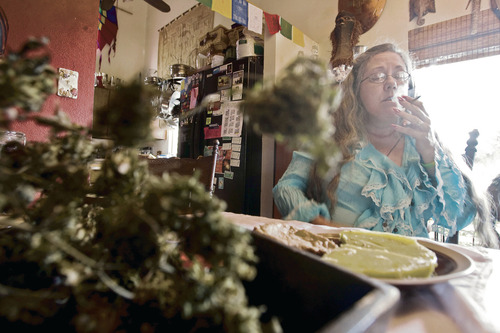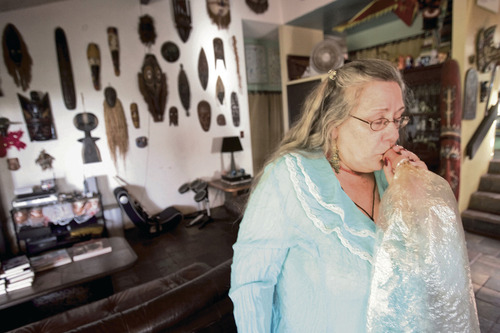Profitable pot

Multiple sclerosis sufferer Teri Heede smokes marijuana in her Makakilo home. In the foreground is some of her medical marijuana supply, as well as a cannabis-laced cookie and cannabis-infused butter.

Teri Heede of Makakilo suffers from multiple sclerosis, which causes frequent immobility and blindness. She uses an eighth of an ounce of marijuana a day, which she says keeps the condition at bay. “Pills weren’t working.” But although she’s a certified medical marijuana user, to get the drug she and others must break the law. “There is no other way to purchase it, except illegally,” said Heede, who has lobbied lawmakers for the past two years to establish marijuana dispensaries in Hawaii.

At left, multiple sclerosis sufferer Teri Heede smokes marijuana in her Makakilo home. In the foreground is some of her medical marijuana supply, as well as a cannabis-laced cookie and cannabis-infused butter. Top, Heede inhales through a vaporizer and, above, rolls a marijuana cigarette. Heede said that when she can't grow the marijuana she needs to keep her condition at bay, she has to buy it from illegal sellers. "There is no other way to purchase it, except illegally, so there is no legal mechanism for us to comply with the law."

Heede inhales through a vaporizer.




Medical marijuana has become a lucrative business in Hawaii.
Legal users soared to more than 8,000 over the past decade from 255 in 2001, the program’s first year.
VARYING LAWS Fifteen states and Washington, D.C., have medical marijuana programs, but laws vary from state to state: LEGISLATIVE EFFORTS Bills related to medical marijuana that are still alive in the Legislature: |
$38 million a year, with patients consuming an average of 1 ounce per month at a street price of $400.
It’s a burgeoning business for doctors, who charge as much as $300 to certify medical marijuana patients. The consultation typically lasts an hour and often is not covered by medical insurance.
There were 175 physicians licensed to certify medical marijuana patients as of June, up from 35 in 2001, according to the Narcotics Enforcement Division of the state Department of Public Safety.
Don't miss out on what's happening!
Stay in touch with breaking news, as it happens, conveniently in your email inbox. It's FREE!
The state charges a $25 processing fee for a medical marijuana certificate. Patients are required to be certified annually.
Hawaii’s medical marijuana law allows patients with a debilitating condition — such as cancer, AIDS, glaucoma, severe pain or nausea — to use the drug if they are certified by a physician registered with the state. It is still illegal to buy marijuana, but patients can grow it legally.
Matthew Brittain, a licensed clinical social worker and substance abuse counselor on the Big Island, has built a niche for himself referring potential medical cannabis users to doctors. Brittain has about 600 active patients and charges as much as $100 for referrals and handling the paperwork.
"We’re in this to make money — I wouldn’t spend the time if I weren’t making money because I have to pay my bills," said Brittain, who also is a certified medical cannabis user for a degenerative back condition.
The Big Island, which has 13.6 percent of the state’s population, accounts for 57.8 percent of the medical marijuana certificates.
Out-of-state doctors are also benefiting from the increase in Hawaii patients. Doctors from the Hemp & Cannabis Foundation, based in Portland, Ore., make frequent trips to the islands. The company charges $250 for a marijuana certificate, including the $25 state fee.
"There’s a big market," said Keith Kamita, deputy director for law enforcement at the Department of Public Safety, which administers the medical marijuana program.
What concerns law enforcement officers is that certain doctors are willing to issue medical marijuana certificates to patients who are not suffering from major illnesses.
"Is there a true doctor-patient relationship, or are they just paying a fee to smoke marijuana?" Kamita asked. "There are some questionable practices."
Kamita said the bulk of marijuana permits are for residents in their 20s and 30s, most of whom cite severe pain as their medical condition.
"We know that the ages are younger and we’re getting more and more minors … which concerns us," Kamita said. "Because the term is so broad, doctors are interpreting it in their own manner. We don’t see what their diagnosis is. It’s not what the original (law) was intended for. It was touted as this would be a last-resort type of drug, but that’s not the case."
Dr. Jim Berg, a Big Island physician, has issued the most marijuana certificates since the law was passed, according to state records. The Narcotics Enforcement Division records showed Berg had authorized 2,957 certificates as of June 2010.
Berg disputed that number, but said he doesn’t keep count. He said he typically charges between $125 and $150 per office visit.
Once the marijuana certificate is issued, patients in Hawaii have to break the law to acquire the drug. Buying marijuana or the seeds to grow the plant is illegal even with a certificate. Certified patients or caregivers can jointly grow seven plants — three mature and four immature, or nonflowering — and have up to 1 ounce of usable marijuana per mature plant.
"What they’ve done is created a law that makes somebody break it in order for the law to be fulfilled. It’s a Catch-22," Berg said. "An unbelievably high percentage of my patients are extremely law-abiding patients. People who are coming for medical marijuana usually want to be legal; they’re trying to do what the state wants them to do."
Patients or their caregivers often end up buying pot, paying as much as $400 an ounce.
"When I can’t grow it … I spend (money) or I don’t walk," said Teri Heede, a 55-year-old Makakilo resident and retired computer engineer suffering from multiple sclerosis, which causes her frequent blindness and immobility. "There is no other way to purchase it, except illegally, so there is no legal mechanism for us to comply with the law."
Heede said she used to take 25 to 30 pills a day to alleviate her condition. Now she uses at least one-eighth of an ounce daily and virtually no pills.
"Marijuana holds it at bay and in some cases totally alleviates it," said Heede, who has lobbied lawmakers for the past two years to establish marijuana dispensaries in Hawaii. "Pills weren’t working."
Fifteen states and the District of Columbia have medical marijuana programs. In many states, the industry is growing rapidly with new fields emerging for cutters, growers, rippers, testers and so-called bud tenders, who help patients choose the right strain of weed for their illness.
Illegal cannabis sales nationwide are estimated at $35 billion to $40 billion, according to the National Organization for the Reform of Marijuana Laws in Washington, D.C.
The United Food & Commercial Workers Union, Local 5, in Californiahas organized 200 medical cannabis members and has another 400 workers whose collective bargaining contracts still must be negotiated, said Dan Rush, Local 5 cannabis division director.
In California, the nonprofit medical cannabis companies "generate a tremendous amount of revenue, which makes them willing to want to pay their workers well," Rush said.
The union has recognition agreements with cannabis companies that will be employing another 2,100 people in California within the next year, Rush said. "What we’re trying to do is take that from the black market and bring it to the open market."




